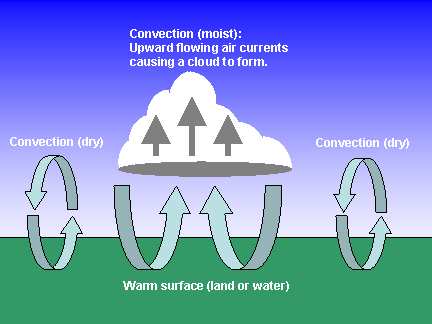
How Tornados Form
Tornados hold destructive power with fatal beauty which induce those tornado chasers to take risk of their lives for learning more about this mysterious funnel dropped from the sky. Still, underestimating the power of tornados is something doomed. The air
columns of tornados range
from ten to hundreds meters
in diameter. The lifespans of
tornados are not equivalent
as well. While it can be so
short that it may only sustain
less than a minute, it also can
prolong for hours from time
to time. Additionally, the
speed of tornados reaches up
to four hundred and eighty
kilometers per hour. Tornados can tear down those fragile buildings, uproot trees, and shatter cars easily. Because of the fatality by tornados, meteorologists and tornado chasers dedicate numerous time and energy to know more about them. In the following, the development of tornados will be decomposed into three stages.

First of all, we start with the essential element of tornados’ formation which is thunderstorm. Nonetheless, not every thunderstorm is correspondent with the conditions of a tornado. A thunderstorm that is particularly powerful and massive is called supercell which is able to build up the base of a tornado. The height of a lofty supercell can expand to fifty-thousand feet, and it brings the fierce gale, acute hailstones, and flooding with bolts of terrific lightning concurrently. Thunderstorms are produced by the rising warm air. We know one of the characteristics of warm air is that it will climb, while the cool air will descend. When the warm air touches the coldness high above the sky, the vapor in the air will condense into clouds. In the meanwhile, vapor will release heat and become little drips of water. Simultaneously, the heat will accelerate the updraft of warm air. Soon after this circle circulates for a while, the thunderstorm will be strengthened and become stronger and more towering. Eventually, the thunderstorm becomes the supercell. This is the full process of supercell’s formation, which is also the basic requirement of breeding tornados.

Subsequently, we proceed to the embryonic miniature of tornado that is funnel cloud with spiral vortex. To construct the funnel from the supercell, the rampant convection of warm air and cool air is indispensable. In the beginning of the convection, the downdraft of cool air meets the rising warm air, and they
entwine mutually and scroll into
horizontal vortex of air. At the same
time, the supercell gets enough
moisture base, which provides the
excellent ingredient for the formation
of tornado, from the ferocious updraft
of warm air with adequate vapor.
On top of that, under the relentless
and consistent updraft of warm air,
the horizontal vortex of air manages
to be turned into a vertical vortex
surrounded by the supercell, and this vertical and spiral vortex pulls down the funnel cloud, which is so-called mesocyclone, from the ample moisture. To notice, in this stage, the tip of the funnel isn’t strong enough to touch the ground yet. It still needs a final push to become fully mature.



Lastly, to build up the connection between the sky and the earth, we need the assistance of cool air. Before long, the funnel cloud, as known as mesocyclone, is completed, the sinking cool
air will wrap the outside of
the funnel. We call the cool
air wrapping the funnel rear
flank downdraft. Through the
pressure of this sinking cool
air, the funnel will be
squeezed into a smaller area,
and the speed will be
increased as well. When the
force of downdraft cool air
is heavy enough, the tip of the
funnel cloud is capable to touch down on the ground, and the tornado is formally born.
From the above, we can organize the formation of tornados into three stages. At first, we need a thunderstorm to be the base ingredient of tornado. The thunderstorm is demanded to be a very strong one, and we call it supercell. In the second stage, we work on building up the funnel cloud from the supercell. The convection between updraft of warm air and downdraft of cool air forms horizontal vortex. Then the constant updraft of warm air produces the sufficient moisture for the supercell and turns the horizontal vortex into vertical vortex. The vertical vortex drags down the funnel cloud, which is known as mesocyclone from the moisture base of supercell. However, the tip of the funnel doesn’t touch the ground yet. In the final stage, with the downdraft of cool air called rear flank downdraft, the funnel cloud becomes thinner, and the speed of its vortex becomes faster. Consequently, the downdraft of cool air forces the funnel cloud to connect with the ground, and the tornado is formed.

To sum up, we human beings devote enormous efforts to understand tornados and try to avoid the serious losses in life and property. Although we still cannot accurately predict when and where the tornados will happen; fortunately, with the progression of human technology, weather-surveillance technology such as Doppler radar helps us to take a further step in detecting tornado by the records of vapor. When a tornado takes place, we have to hide at the basement with stable pillars as soon as possible. In the outdoors, we should avoid approaching buildings, trees, electricity poles, bridges, and so on and quickly lie down on the lower ground. Hope we can decrease the losses and fatality by tornados into the smallest scale one day.
Reference
The Science in Our Life. How do tornados form? Retrieved from https://www.facebook.com/Science.daai/videos/1818770635042190/
Encyclopaedia. How do tornados form? Retrieved from https://www.britannica.com/story/how-do-tornadoes-form
Digital Popularization of Science Website by Central Weather Bureau. (2019). Look into the horrific tornados. Retrieved from https://pweb.cwb.gov.tw/PopularScience/index.php/weather/199-2017-02-02-05-54-21
TED-Ed. (2014). How do tornados form? Retrieved from https://www.youtube.com/watch?v=lmWh9jV_1ac